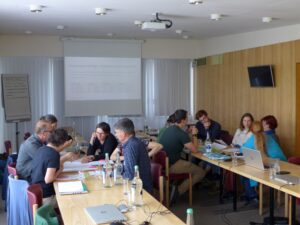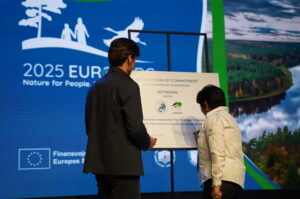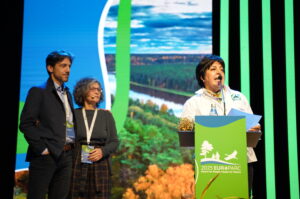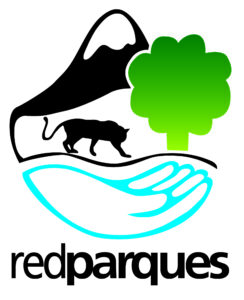Become the host of the EUROPARC Conference 2027!
Do you want to put the spotlight on your country and its Protected Areas? Do you want to open your doors to nature conservationists from across Europe? Now is your chance: make a bid to host the EUROPARC Conference 2027!
Bringing the Protected Area community together
The EUROPARC Conference is a unique moment for Protected Area professionals in Europe to get together and exchange on their work, learn from each other, discuss key Protected Areas topics, and create connections that can last a lifetime.
Furthermore, the event provides a privileged opportunity for the host organisation to showcase their country, conservation achievements, Protected Areas, and culture to an audience of experts coming from across Europe and beyond.
Your organisation now has the opportunity to host the EUROPARC Conference 2027!
Process for making a bid
When preparing your bid, please consider the following:
- The host organisation(s) should be, or be connected to, a EUROPARC member.
- Please prepare a letter signed by the responsible person(s) from the host organisation, indicating the willingness to host a EUROPARC Conference. The following information should be included:
- Reasons and purpose for hosting.
- Possible themes to explore.
- Location of the Conference.
- Commitment to raise the necessary funds.
- Information on how the bid meets all the elements of guidance contained in this document.
- Any additional information on prospective venue and location, like its capacity, as well as the different travel options available to reach the venue.
- Please consult the detailed guidance document to prepare your bids.
Guidance for aspiring Conference hosts
The EUROPARC Council is responsible for deciding the host, in consultation with the Directorate involved in the Conference planning. In the event of multiple bids being received, the Council will compare and evaluate each bid to reach their decision.
For the EUROPARC Conference 2027: Bids should be received by February 27th 2026 and a decision will be announced by the end of March. Successful hosts should be available to announce the Conference by September 2026 (details to be agreed).
We look forward to receiving your bids!

Contact us!

Acting for climate – from committments on paper to actions in parks
Haltestelle Kreuzplatz ©Schaffhauserland Tourismus / Seraina Keiser
Acting for climate – from committments on paper to actions in parks
Facing the growing challenges of climate change, the Swiss Park Network has adopted a joint Climate Mission Statement to strengthen climate actions and adaptation across its 20 Regional Nature Parks.

The directors of the Swiss parks working on the climate policy (c) Swiss Parks
This shared commitment sets a clear direction for how parks can protect biodiversity, support local communities, and act as practical models of sustainability in their regions. In our new case study, you can read more about the joint development of the Climate Mission Statement.
Case Study - EN Case Study - DEOne inspiring climate mitigation action from the Swiss Park Network is the Clientis Randenbus in the Regional Nature Park Schaffhausen, a local mobility project that reduces car traffic in the Randen recreation area and promotes sustainable tourism. Born from cooperation between farmers, municipalities, and transport services, the Randenbus offers a simple yet effective example of how climate goals can be translated into everyday practice.
Case Study - EN Case Study - DEAll across Europe, Nature Regional Landscape Parks play a vital role in linking people and nature—preserving landscapes shaped by human use while fostering sustainable regional development.
Learn more about these two inspiring examples from our Swiss Park Network, an active member of the Nature Regional Landscape Parks Taskforce of EUROPARC!
From Europe to Latin America – connecting Protected Areas
Photo credit: Vaidas Garla
On Wednesday 8th of October EUROPARC Federation reached out over the Atlantic Ocean to shake a hand with our sibling organisation RedParques from Latin America.
From Europe to Latin America – connecting Protected Areas

Photo credit: Vaidas Garla
At the EUROPARC Conference 2025 in Birštonas, Lithuania, EUROPARC and RedParques shook hands and signed a declaration of commitment which aims to connect Protected Areas across oceans.
The delegation from RedParques was headed by the current Regional Coordinator, Ms. Hilda Ángel, who is also the General Manager of National Parks and Natural Monuments of the National Institute of Parks (INPARQUES) of Venezuela. Ms. Dayana Porras, the Technical Focal Point for the Regional Cooperation of RedParques and Specialist in INPARQUES participated in the delegation along with Mr. Edgar Vicuña, Deputy Director of Strategic Information and Research of the National Service of Natural Protected Areas (SERNANP) of Peru. The delegation also included Mr. Pietro Graziani, Regional Technical Coordinator of the Italian Development Cooperation Agency (AICS) of the programme AMAZONÍA+.
In the declaration of commitment, EUROPARC and RedParques agreed to formalise the collaboration with preparation of a Memorandum of Understanding and accompanying work plan. This is a logical step as both organisations work on strengthening the management of Protected Areas, and share common objectives for biodiversity conservation, sustainable development and capacity building.

Photo credit: Vaidas Garla
The themes for collaboration include:
- Capacity development and knowledge management.
- Communication, awareness-raising, and public participation.
- Policy dialogue and international cooperation.
The joint activities could include exchange of information, methodologies, and good practices through e.g. organisation of workshops and technical meetings. In effect, the organisations have already hosted several workshops together, with EUROPARC Spain taking a lead role.
EUROPARC is looking forward to exploring the possibilities of this cooperation.
Quote from Hilda Ángel:
We are convinced that, though we are two continents geographically apart, we are very similar because we both have one common goal which is the conservation of Protected Areas.

More about RedParques
RedParques is a regional network of technical cooperation among the countries of Latin America and the Caribbean, aimed at strengthening Protected Areas, biodiversity conservation, and sustainable development. Participating 23 countries seek to share lessons learned and good management practices to scale up the impact of Protected Areas in the region.
25 Years of the Council of Europe Landscape Convention
On 27 and 28 October 2025, EUROPARC joined ministers, landscape experts and partners from across Europe in Florence, Italy, to celebrate the 25ᵗʰ Anniversary of the Council of Europe Landscape Convention. The event was organised by the Council of Europe and the Italian Ministry of Culture, marking a quarter-century of work to recognise, protect, and care for Europe’s landscapes.
Aims of the Landscape Convention
Since it was first signed in Florence in 2000, the Landscape Convention, formerly known as the European Landscape Convention, has inspired countries across Europe to see all landscapes as vital parts of people’s quality of life and cultural identity. Over the years, it has encouraged communities and governments to work together to plan and manage their landscapes in sustainable and inclusive ways. To date, it is ratified by 40 Member States. The Convention is based on the assumption that landscape is a key element, an essential component of human beings’ surroundings, and an important part of their quality of life. It thus helps to strengthen the link between human rights and the environment with a view to their mutual protection and enhancement.
About the event
During the meeting, the work relating to the recommendations of the Committee of Ministers on “Landscape, a living environment”, on “Landscape and health” and on “Water resources under stress” were illustrated. Furthermore, the guidelines for action in the coming year were discussed, and one of the main topics was environmental protection to combat the triple global crisis of pollution, climate change and biodiversity loss. The discussions were guided by the Reykjavík Declaration (2023) and the Council of Europe’s new Strategy on the Environment (2025 – 2030), both of which underline the importance of landscapes in tackling pollution, climate change, and biodiversity loss.
EUROPARC was represented at the event by Council member Lidia Bai, who joined the discussions on the future of landscape governance and the essential role that Protected Areas play in shaping sustainable landscapes across Europe. She states:
It is clear that the Landscape Convention, on the basis of the Reykjavik Declaration, is focusing its attention on many issues that are at the heart of the EUROPARC Federation’s action: climate change mitigation, sustainable development, biodiversity protection, among others. It is important that many different organisations in Europe are working concretely on these issues and it is important that increasingly closer cooperation can be developed in the future.
At the conclusion of the October 28 meeting, the Conference produced a statement Declaration to be adopted by the Ministers and other State representatives. This Declaration will outline a strategic vision to strengthen multilateral cooperation and promote the effective implementation of the Convention and its integration into national policies.
EUROPARC’s Members continue to play a key role in turning the values of the Landscape Convention into real action on the ground. Especially, EUROPARC’s Taskforce for Nature Regional Landscape Parks are a driving force in:
- Applying good practices and practical tools for sustainable landscape management
- Strengthening the voice of landscape parks at the European level
- Supporting policy integration between nature, culture, and community development
- Encouraging collaboration between people and places to ensure that landscapes remain vibrant and resilient
John Watkins, Chief Executive at the National Landscape Association in the UK and an active member of EUROPARC’s Nature Regional Landscape Parks Taskforce, states:
The mission of Landscape and Regional Parks takes inspiration from, and puts into practice, the Convention’s definition of landscape: ‘an area, as perceived by people, whose character is the result of the action and interaction of natural and/or human factors. Across Europe, these places are an ongoing celebration of the bond between people and place, and this relationship is critical to tackling loss of nature and the effects of climate change.
Not only the Nature Regional Landscape Parks, but the whole EUROPARC family, aim to bridge policy and practice with their work— ensuring that the spirit of the Landscape Convention continues to thrive across Europe.